Is this thing working? Yes! A working computer – with internet access. Amazing. This log is to inform anyone who finds it about what caused the end of humanity. The Mayans were right, and on December 21st, 2012, the world was destroyed. But it didn’t come from fire or flood, no. It came in the form of a series of massive bacterial plagues, killing almost everyone, and soon one of them will take me. This is the story of the Pandemic.
It all starts relatively benignly. The map here, of course represents the world. And each of those cubes? That’s tens, hundreds of thousands – perhaps millions – of sick and dying people. Naturally, I and my fellow aid workers tried to stop the spread of the diseases, but of course, we were unprepared. How can you deal with up to five distinct diseases, all spreading rapidly across the globe?! Well, as is obvious by now, we couldn’t. But Here’s how we tried…
Each player in Pandemic will take on the role of a CDC worker, all working together to stop the coming plagues. At the start of the game, disease cubes will be spread around the board randomly, while the players always start in Atlanta (home of the CDC.) On each turn you’ll get to take four actions, which are divided into Basic Actions (basically just different types of move actions) and Special Actions (everything else.) You’ll also get a hand of cards, each of which depicts one city on the board and showing that city’s corresponding color. These are a few special cards as well, some of which can be quite powerful, but it is the city cards that run the game.
Moving is relatively easy. You can move along any of the lines printed on the board, from one city to the next, for one action. But moving that slow can be costly, as disease waits for no man! So, there are three other ways to move around, using air travel. The first is a Direct Flight. This is accomplished by discarding a city card from your hand and moving directly to that city. The next is a Charter Flight which lets you fly to ANY city by discarding the card for the city you are currently in. Finally, you can fly directly from any city with a research station to any other city with a research station for no cards at all! Of course, this is (often) of limited use early in the game as you start with only a single research station in Atlanta.
The purpose of all of this moving is get you into position to perform the Special Actions, each of which serves an important purpose. The first is to build a new research station, accomplished by discarding the card for the city you are currently in. This not only helps with movement (flying between stations without the use of a card) but a research station is also the only place you can perform the next (and most important) action: discovering a cure. To find a cure, you have to be at a station and discard five cards, all of which must match the color of the disease you want to cure. Of course, curing a disease isn’t the same as treating it. For that, the next action comes in. For one action, you can remove one disease cube from the city you’re in, or if the cure for that disease has been found, you can remove them all! The final special action is to give a card to another player or take take one from them. This one always trips up new players, as it has a couple of restrictions: you both have to be in the same city, and you can only give or take the card for the city you are both in. Want to get the Mumbai card? You had better both be in Mumbai, or no dice.
Each turn, after you take your four actions, you get to draw two more cards. Unfortunately, mixed in with the city and special cards at semi-random intervals are some number of Epidemic cards (side note, you can actually set the difficulty of the game by deciding how many of these you want to use! What a great mechanic!) These are just as bad as they sound, but a bit more on them in a minute.
The final thing you do on your turn is to see how the diseases spread around the globe. You’ll draw two infection cards, each of which has a city pictured on it, and add one disease cube to each. If any city gets three cubes of the same color on it, it Outbreaks, spreading cubes to EVERY CITY IT IS CONNECTED TO. And remember those Epidemic cards? When one is drawn, it automatically adds three cubes to one city AND THEN reshuffles the Infection cards from the discard pile and puts them back on top of the Infection pile. That means that the next time you draw infection cards, you’re adding cubes to cities that have ALREADY GOTTEN CUBES PUT ON THEM! Oh, and any of these things can also just make you lose the game. If you ever get to eight outbreaks, you lose the game automatically. If you ever run out of cubes of any color, you lose the game automatically. If you ever run out of player cards in the draw pile, you lose the game automatically.
At that point, finally, your turn will be over.
So how do you win this thing? Well, although there are three ways to lose, there is only one way to win (in the basic game): you have to find the cures for all of the diseases. This means you have a really tricky balancing act to maintain, which is the true genius of the game. You need to keep the cubes on the board in check, but by doing so you’re actually wasting time, as they are meaningless toward the actually winning the game. This means the players will often split up, each one choosing a job to do in the game, which is often determined by which Role you are given when the game starts. Each role has a special power; some help with curing diseases, some are good at treating cubes, some are good at trading cards, some help you move other players around, etc. It is important for each player to recognize what their role is good at doing, and sticking to it. But never forget the goal of the game. Getting distracted by the siren’s song of removing cubes is all too easy, and can turn a sure thing into a soul-crushing defeat. This game is incredible tense and nerve wracking. The main disease Pandemic dishes up is a healthy dose of sour-stomach. If you’ve enjoyed Castle Panic and you’re looking for an upgrade in cerebral play, please, please check out Pandemic. This game sets the co-op gold standard.
All of the pictures in this review are a combination of the base game and the expansion, called On the Brink. I HIGHLY recommend this expansion. It isn’t necessary, but it adds some really cool things, including: the totally sweet Petri dishes for the cubes, the fifth disease (disease), new ways to play around with the difficulty, new roles, new special cards, and an entirely new way to play the game with the addition of a bio-terrorist player who plays against everyone else.
So that’s my story. We couldn’t hold off the outbreaks. Disease appeared spontaneously all across the globe. We couldn’t react fast enough. Billions died.
So we just set it all up again and started over. 


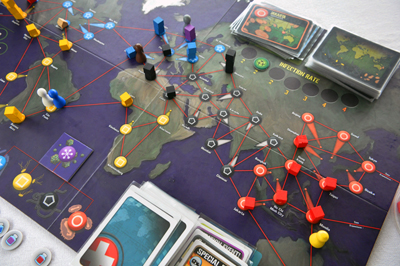
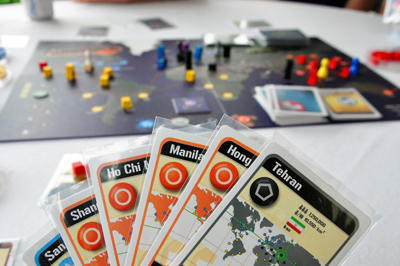
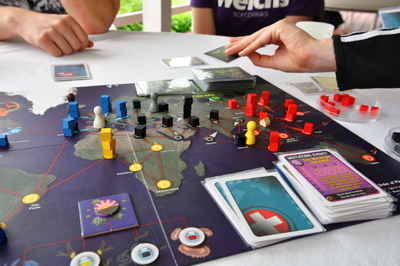
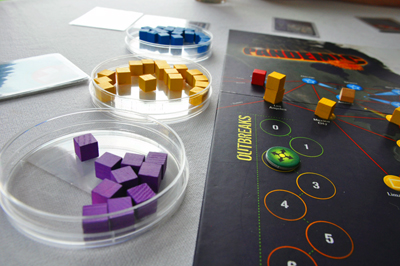
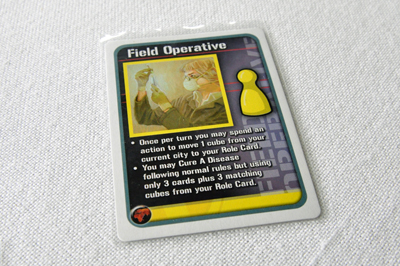
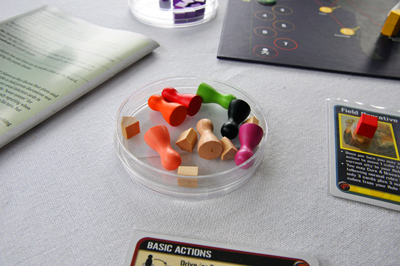
Love this game. Great review.
Thanks Josh!
I feel like this game would make me flap my hands around a lot!
I agree! We’ll play it soon!
I went to our local board game store (called Eclectic Games) to inquire about a) board game night and b) Pandemic, and found out that it is currently out of stock in the entire country. Which is both awesome and awful, because we want to buy it, but we don’t want to buy it this second anyway.
Yeah, so as it turns out, Pandemic is currently out of print. BUT! they are reprinting it with new graphics and stuff and new expansions. I believe it will be out this spring.